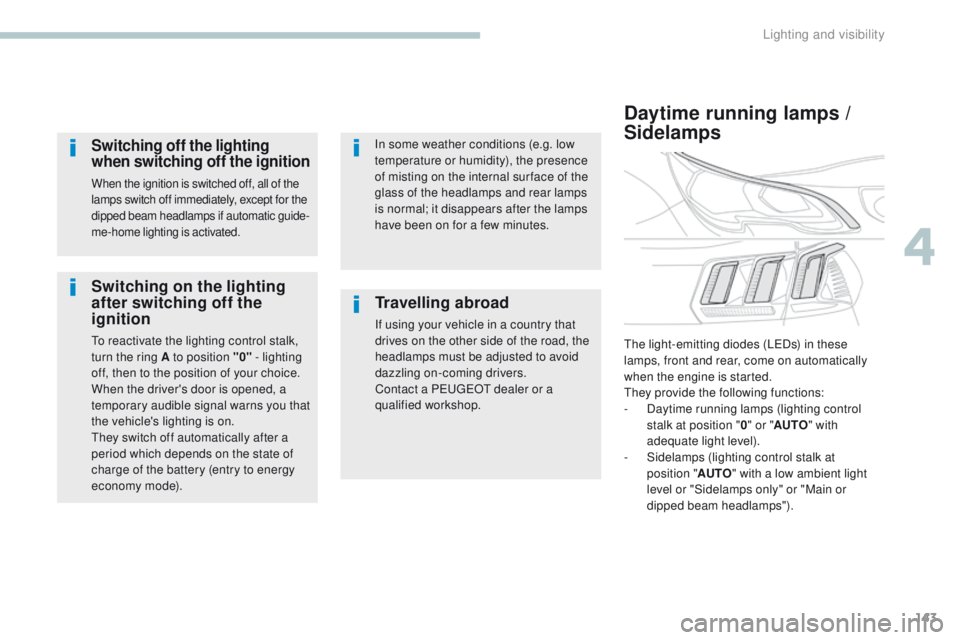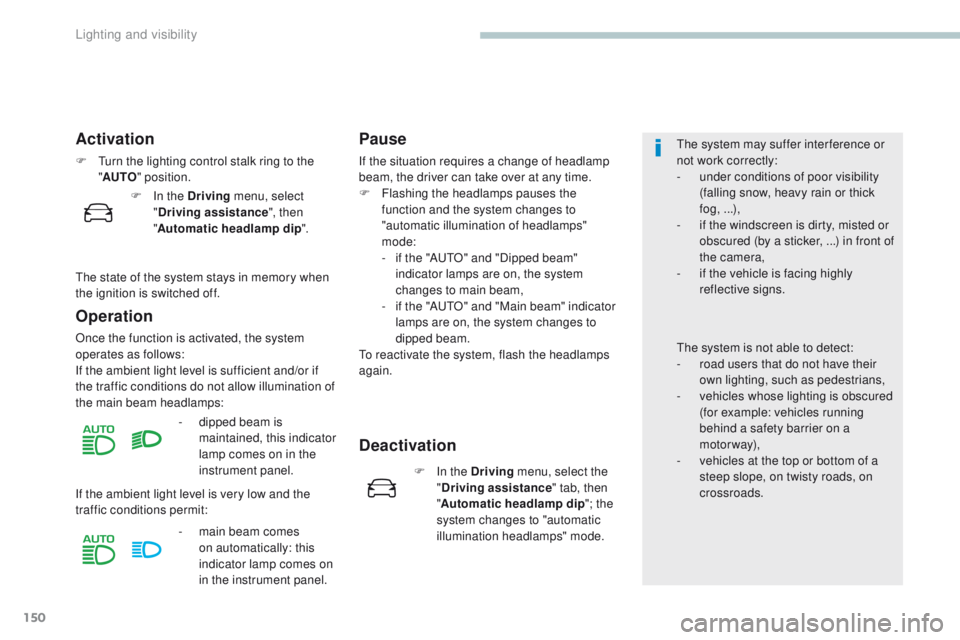Page 118 of 566

116
3008-2_en_Chap03_ergonomie-et-confort_ed01-2016
Front demist - defrost
With semi-automatic and
automatic air conditioning
With Stop & Start, when the demisting,
air conditioning and air flow functions
are activated, STOP mode is not
available.
Automatic visibility programme
With Stop & Start, when demisting has
been activated, the STOP mode is not
available.
The system automatically manages the air
conditioning (depending on version), air
flow and air intake, and provides optimum
distribution towards the windscreen and side
windows.
F
T
o switch it off, press this button; its
indicator lamp goes off.
With manual air
conditioning
F Adjust the temperature to maximum (red).
F A djust the air flow to maximum; all the
indicator lamps come on.
F
A
djust the air distribution to the
" Windscreen" position; its associated
indicator lamp comes on.
F
C
heck that recirculation of interior air is
deactivated; its indicator lamp must be off.
F
S
witch on the air conditioning by pressing
the " A/C" button; its indicator lamp comes
on. F
P
ress this button to demist or
defrost the windscreen and side
windows as quickly as possible;
its indicator lamp comes on.
The system allows the manual modification of
air flow without causing automatic deactivation
of the automatic visibility programme.
Ease of use and comfort
Page 119 of 566
117
3008-2_en_Chap03_ergonomie-et-confort_ed01-2016
Heated windscreen
Switching on
Switching off
With the engine running, press this
button; its indicator lamp comes on.
Pressing the button again switches off
the system; its indicator lamp goes off.
The system is automatically deactivated every
time the engine is switched off. The system is active if the ambient temperature
is below 0°C.
In cold weather, this system heats the bottom of
the windscreen, as well as the areas alongside
the windscreen pillars.
Without changing the settings for the air
conditioning system, it allows faster release
of the windscreen wiper blades when they
are frozen to the windscreen and avoids
the accumulation of snow resulting from the
operation of the windscreen wipers.
3
Ease of use and comfort
Page 144 of 566

142
3008-2_en_Chap04_eclairage-et-visibilite_ed01-2016
In good or rainy weather, by both
day and night, use of the front and
rear foglamps is prohibited. In these
situations, the power of their beams
may dazzle other drivers. They should
only be used in fog or falling snow.
In these weather conditions, you should
switch on the foglamps and dipped
beam headlamps manually, as the
sunshine sensor may detect sufficient
light.
Do not forget to switch off the foglamps
when they are no longer necessary.
Foglamps
Rear foglamps
The sidelamps or dipped or main beam
headlamps must be on.
Front and rear foglamps
The main or dipped beam headlamps
must be on.
Rotate and release ring C :
F
fo
rward to switch on the rear foglamps.
F
b
ackward to switch them off. Rotate and release ring C
:
F
f
or ward a first time to switch on the front
foglamps,
F
f
or ward a second time to switch on the rear
foglamps,
F
b
ackward a first time to switch off the rear
foglamps,
F
b
ackward a second time to switch off the
front foglamps.
Lighting and visibility
Page 145 of 566

143
3008-2_en_Chap04_eclairage-et-visibilite_ed01-2016
Switching on the lighting
after switching off the
ignition
To reactivate the lighting control stalk,
turn the ring A to position "0" - lighting
off, then to the position of your choice.
When the driver's door is opened, a
temporary audible signal warns you that
the vehicle's lighting is on.
They switch off automatically after a
period which depends on the state of
charge of the battery (entry to energy
economy mode).
Daytime running lamps /
Sidelamps
The light-emitting diodes (LEDs) in these
lamps, front and rear, come on automatically
when the engine is started.
They provide the following functions:
-
D
aytime running lamps (lighting control
stalk at position " 0" or " AUTO " with
adequate light level).
-
S
idelamps (lighting control stalk at
position
"AUTO " with a low ambient light
level or "Sidelamps only" or "Main or
dipped beam headlamps").
In some weather conditions (e.g. low
temperature or humidity), the presence
of misting on the internal sur face of the
glass of the headlamps and rear lamps
is normal; it disappears after the lamps
have been on for a few minutes.
Travelling abroad
If using your vehicle in a country that
drives on the other side of the road, the
headlamps must be adjusted to avoid
dazzling on-coming drivers.
Contact a PEUGEOT dealer or a
qualified workshop.
Switching off the lighting
when switching off the ignition
When the ignition is switched off, all of the
lamps switch off immediately, except for the
dipped beam headlamps if automatic guide-
me-home lighting is activated.
4
Lighting and visibility
Page 151 of 566
149
3008-2_en_Chap04_eclairage-et-visibilite_ed01-2016
Automatic headlamp dipping
This system is a driving aid.
The driver remains responsible for the
vehicle's lighting, its correct use for the
prevailing conditions of light, visibility,
traffic and observation of driving and
vehicle regulations.
The system will be operational as soon as
you have exceeded 15 mph (25 km/h).
If the speed drops below 9 mph (15
km/h),
the system no longer operates.
System which automatically changes between dipped and main beam according to the ambient light level and the driving conditions, using a camera
located at the top of the windscreen.
4
Lighting and visibility
Page 152 of 566

150
3008-2_en_Chap04_eclairage-et-visibilite_ed01-2016
Activation
F Turn the lighting control stalk ring to the "AUTO " position.
Operation
Once the function is activated, the system
operates as follows:
If the ambient light level is sufficient and/or if
the traffic conditions do not allow illumination of
the main beam headlamps:
Pause
If the situation requires a change of headlamp
beam, the driver can take over at any time.
F
F
lashing the headlamps pauses the
function and the system changes to
"automatic illumination of headlamps"
mode:
-
i
f the "AUTO" and "Dipped beam"
indicator lamps are on, the system
changes to main beam,
-
i
f the "AUTO" and "Main beam" indicator
lamps are on, the system changes to
dipped beam.
To reactivate the system, flash the headlamps
again.
-
d
ipped beam is
maintained, this indicator
lamp comes on in the
instrument panel.
If the ambient light level is very low and the
traffic conditions permit: -
m
ain beam comes
on automatically: this
indicator lamp comes on
in the instrument panel.
Deactivation
The system may suffer interference or
not work correctly:
-
u
nder conditions of poor visibility
(falling snow, heavy rain or thick
fog, ...),
-
i
f the windscreen is dirty, misted or
obscured (by a sticker, ...) in front of
the camera,
-
i
f the vehicle is facing highly
reflective signs.
The system is not able to detect:
-
r
oad users that do not have their
own lighting, such as pedestrians,
-
v
ehicles whose lighting is obscured
(for example: vehicles running
behind a safety barrier on a
motorway),
-
v
ehicles at the top or bottom of a
steep slope, on twisty roads, on
crossroads.
F
I
n the Driving menu, select
" Driving assistance ", then
" Automatic headlamp dip ".
F
I
n the Driving menu, select the
" Driving assistance " tab, then
" Automatic headlamp dip "; the
system changes to "automatic
illumination headlamps" mode.
The state of the system stays in memory when
the ignition is switched off.
Lighting and visibility
Page 154 of 566

152
3008-2_en_Chap04_eclairage-et-visibilite_ed01-2016
Programming
Your vehicle may also include some functions
that can be configured:
-
a
utomatic rain sensitive windscreen wipers,
-
r
ear wiping on engaging reverse gear.
In wintry conditions, remove snow, ice
or frost present on the windscreen,
around the wiper arms and blades and
the windscreen seal, before operating
the wipers.Without AUTO wiping
With AUTO wiping
Windscreen wiper
A. Wiping speed control stalk: raise or lower the stalk to the desired position.
Fast wiping (heavy rain).
Normal wiping (moderate rain).
Intermittent wiping (proportional to
the speed of the vehicle).
Park.
Single wipe (press downwards or pull
the stalk briefly towards you, then
release).
Automatic wiping (press
down, then release).
or
Wiper control stalk
Single wipe (pull the stalk briefly towards you).
Do not operate the wipers on a dry
windscreen. Under extremely hot or
cold conditions, ensure that the wiper
blades are not stuck to the windscreen
before operating the wipers.
Lighting and visibility
Page 160 of 566

158
3008-2_en_Chap05_securite_ed01-2016
Emergency or assistance call
If an impact is detected by the airbag
control unit, and independently of
the deployment of any airbags, an
emergency call is made automatically.
PEUGEOT Connect SOS
In an emergency, press this
button for more than 2 seconds.
Flashing of the green LED and
a voice message confirm that
the call has been made to the
"P
E
UGEOT
C
onnect SOS" call
c e nt re*.
Pressing this button again immediately cancels
the request.
The green LED goes off.
The green LED remains on (without flashing)
when communication is established.
It goes off at the end of the call.
" P
E
UGEOT
C
onnect SOS" immediately locates
your vehicle, starts communication with you in
your language**, and where necessary sends
the appropriate public emergency services**. In
countries where the service is not available, or
when the locating service has been expressly
declined, the call is sent directly to the
emergency services (112) without the vehicle
location. * *
D
epending on the geographical cover of
" P
E
UGEOT
C
onnect SOS", "P
E
UGEOT
C
onnect Assistance" and the official national
language selected by the owner of the vehicle. The list of countries covered and PEUGEOT
CONNECT services is available from dealers
or at www.peugeot.co.uk.
*
S
ubject to the general conditions for the
service available from dealers and subject to
technological and technical limitations. If you benefit from the P
E
UGEOT
C
onnect Packs offer with the SOS and
assistance pack included, there are
additional services available to you in
your My P
E
UGEOT
p
ersonal space, via
the Internet website for your country.
Safety